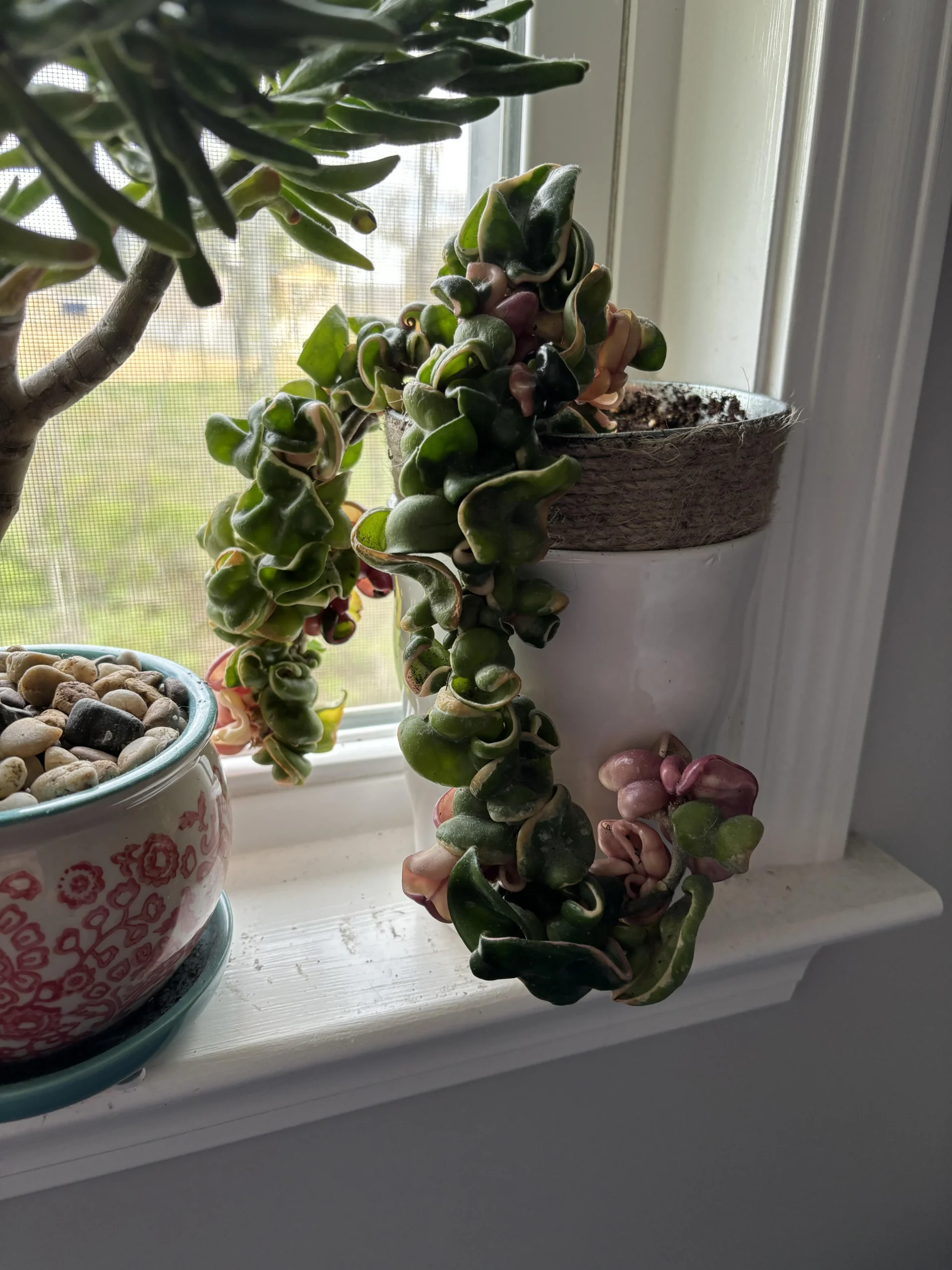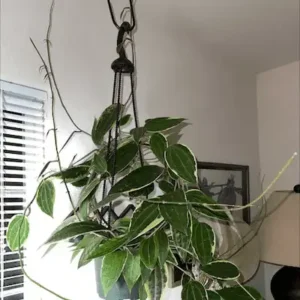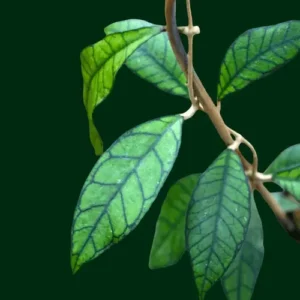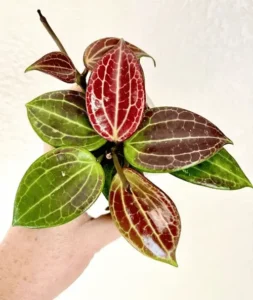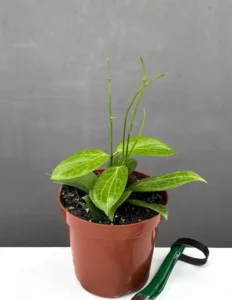Introduction
This guide will dive into every aspect of Hoya Hindu Rope Care, from light and water requirements to propagation and common problems. The Hoya Hindu Rope plant, also known as Hoya carnosa compacta or “Krinkle Kurl,” is highly sought-after due to its unique, twisted, rope-like vines and waxy, succulent leaves and easy to care for. Originating from tropical regions, this slow-growing, epiphytic plant thrives indoors and produces stunning star-shaped flowers, making it a prized addition to any houseplant collection. While relatively easy to care for, it has specific requirements that, when met, ensure healthy growth and even flowering.
Understanding the Hoya Hindu Rope Plant
Before delving into specific care tips, it helps to understand the nature of the Hoya Hindu Rope plant. Like many Hoya species, the Hindu Rope is semi-succulent, meaning its leaves store water, making it drought-tolerant. Its curling leaves create dense, cascading vines, giving it a striking appearance, especially when grown in hanging baskets. The plant’s slow growth rate and unique form make it an appealing choice for those looking for a low-maintenance yet decorative plant.
Hoya Hindu Rope plants are also known for their fragrant, waxy, porcelain-like flowers. While the flowers may take years to appear, they are well worth waiting for, as their clusters of star-shaped blooms are visually stunning and emit a sweet fragrance.
Care Requirements for Hoya Hindu Rope Plant
Here is a detailed analysis of the care requirements for the Hoya Hindu Rope plant.
Light Requirements
Hoya Hindu Rope plants thrive in bright, indirect light. They require a good amount of light to encourage healthy growth and flowering, but they should not be exposed to direct sunlight for long periods, as it can scorch their leaves. Ideally, place your Hoya Hindu Rope near an east- or west-facing window where it can get morning or late afternoon sun, but be protected from the harsh midday rays.
If you live in a low-light environment or your home doesn’t get much natural sunlight, you can supplement the light with artificial grow lights. However, keep in mind that under low light conditions, the plant’s growth may slow down, and it is less likely to flower.
Watering Schedule
As a semi-succulent, the Hoya Hindu Rope plant does not need frequent watering. Overwatering can lead to root rot, which is one of the most common causes of plant death. It’s important to let the soil dry out between waterings.
Here’s a general watering guide:
In Spring and Summer (growing season)
Water when the top 1-2 inches of soil feel dry to the touch. This can range from once every 7-10 days depending on your home’s humidity and temperature.
In Fall and Winter (dormant season)
Reduce watering to once every 2-3 weeks, as the plant’s water needs decrease during this time.
Ensure that the Hoya (plant) is in a well-draining pot to avoid waterlogging the roots. Always empty the saucer beneath the pot after watering to prevent standing water.
Humidity and Temperature
Hoya Hindu Rope plants thrive in environments that mimic their native tropical habitats. They prefer moderate to high humidity, with levels between 40-60% being ideal. If your home is particularly dry, especially in the winter when heating systems are on, consider using a humidity tray or a humidifier to maintain the proper levels.
In terms of temperature, the Hoya Hindu Rope plant prefers a consistent range between 60-80°F (15-27°C). Avoid placing the plant in drafty areas or near air conditioners and heaters, as sudden temperature fluctuations can stress the plant.
Soil and Potting Mix
Proper soil is crucial for the health of a Hoya Hindu Rope plant. Since they are epiphytic, they prefer a loose, well-draining soil that mimics the type of environment they would grow in naturally. A mixture of potting soil with orchid bark or perlite works well. You can also use a cactus or succulent mix, as these are formulated to provide good drainage.
When repotting, it’s best to do so in the spring or early summer. However, Hoya Hindu Rope plants do well when slightly root-bound, so repotting is only necessary every 2-3 years or when the plant has visibly outgrown its pot.
Fertilization
Hoya Hindu Rope plants do not require heavy fertilization, but they do benefit from light feeding during their growing season (spring and summer). Use a balanced, water-soluble fertilizer diluted to half-strength once a month.
Avoid fertilizing during the fall and winter when the plant is in its dormant phase. Over-fertilization can lead to salt buildup in the soil, which may damage the roots.
Pruning and Maintenance
Pruning is not typically required for Hoya Hindu Rope plants, as their slow growth means they don’t become unruly. However, you can trim back the vines if they become too long or if you want to shape the plant. Always use clean, sharp scissors or pruning shears to avoid introducing any disease.
One important tip
Do not remove the long tendrils or peduncles (the stalks from which the flowers bloom). Hoya Hindu Rope plants bloom from the same spot each year, so removing these tendrils can reduce or eliminate the chances of flowers.
Propagation
Hoya Hindu Rope plants are relatively easy to propagate through stem cuttings. Here’s how to do it:
- Select a Healthy Vine
Choose a vine with at least 2-3 nodes (the small bumps where leaves grow) and cut just below a node using clean scissors.
- Prepare the Cutting
Remove the leaves from the lower 1-2 nodes, leaving a few leaves at the top.
- Rooting in Water or Soil
Water: Place the cutting in a jar of water, making sure the nodes are submerged but the leaves are above the waterline. Place the jar in a spot with bright, indirect light, and change the water every few days. Roots should appear in 2-4 weeks, after which you can transfer the cutting to the soil.
Soil: Alternatively, you can plant the cutting directly in moist, well-draining soil. Keep the soil slightly damp, but not soggy, and place the cutting in a warm, humid environment.
- Rooting hormone
Rooting hormone is optional, but it can speed up the process.
Pests and Diseases
Hoya Hindu Rope plants are relatively pest-resistant, but they can still fall victim to common houseplant pests like mealybugs, aphids, and spider mites. Regularly inspect your plant for signs of these pests, such as small white cottony clusters (mealybugs) or fine webbing (spider mites). If you notice any pests, isolate the plant and treat it with insecticidal soap or neem oil.
Root rot, caused by overwatering, is the most common disease issue. If your plant’s leaves turn yellow or become mushy, or if the soil smells bad, you may have root rot. In this case, reduce watering and consider repotting the plant in fresh, dry soil.
Encouraging Blooms
One of the most exciting aspects of growing a Hoya Hindu Rope plant is its beautiful flowers. However, getting them to bloom can be tricky and requires patience. The plant must be mature (3-5 years old) and have optimal growing conditions, including bright, indirect light and slightly cooler temperatures in the winter months.
To encourage flowering:
- Ensure your plant gets plenty of light. If it’s in a low-light area, consider moving it to a brighter location.
- Allow the plant to become slightly root-bound, as this can sometimes stimulate flowering.
- Keep the humidity levels high.
- Feed the plant during the growing season with a phosphorus-rich fertilizer.
Once the flowers appear, they will last for several weeks and can bloom multiple times a year, given the right conditions.
Common Problems and Solutions
- Yellow Leaves
This can be a sign of overwatering, underwatering, or insufficient light. Check the moisture level of the soil and adjust your watering schedule accordingly.
- No Flowers
If your plant is not blooming, it may need more light, or it may not be mature enough to flower yet.
- Leaf Drop
This is often due to a sudden change in the plant’s environment, such as temperature fluctuations, drafts, or too much water. Make sure the plant is in a stable, warm, and well-lit location.
| FAQs How do you take care of a hoya Hindu rope plant? -The plant should be placed in an area with bright, indirect light. -Make use of perlite-containing light, well-draining potting mix. -Once the soil is dry, water deeply; during the winter, water less. -Fertilize in the spring and summer every few months. How to get a Hindu rope plant to bloom? Now let’s look at some care advice for growing and blooming hoyas: -Select the Appropriate Soil. -Maintain Hoyas’ Root Boundary. -Supply Sufficient Bright Light… Attend to Its Watering Requirements. -Hydrate the Hoya plant. -Make sure the environment and humidity are comfortable. Defend against pests. -Trim Any Dead parts. How much sun does a Hoya rope need? For your Hoya, bright, indirect light is best. |
Conclusion
The Hoya Hindu Rope plant is a stunning addition to any home, offering unique foliage and beautiful, fragrant flowers. While it’s a relatively low-maintenance plant, it does have specific care requirements, especially regarding light, watering, and humidity. By following the tips in this guide, you can enjoy a healthy, thriving Hoya Hindu Rope for many years to come.
Remember, patience is key with this slow-growing plant. With the right care, it will reward you with its charming vines and mesmerizing flowers.

